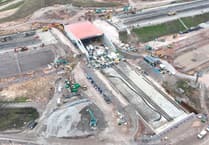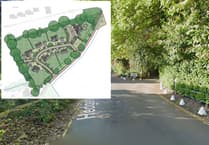Farnham has discovered to its collective misery that West Street will effectively be rendered worthless as a key thoroughfare for six months.
And this is just a first stage of an emergency plan to boost fresh water supply to the new developments allowed by Planners at Coxbridge and Crondall Lane.
Stage two (yet to be announced) will repeat the misery in a separate but unavoidable project when sewage capacity is boosted by a similar volume over the same route.
In quick succession Farnham’s residents learned at end-December that the new developments at Coxbridge and in Crondall Lane urgently required augmented water supplies which, in turn, needed Farnham’s western access to be cut by ‘rolling road-closures’ lasting half a year. Worse, and according to the report in the paper on January 5, Farnham Council were given only 24 hours’ notice by Surrey County Council (SCC), who are responsible for highways, that closure of West Street was both imminent and irreversible and to brace themselves.
As every Farnham resident knows, the town’s charming medieval street pattern which we all cherish enables any single minor obstruction almost anywhere to gridlock the entire town.
This is not only a disgraceful example of frivolous and irresponsible discharge of authority by separate bodies staffed mostly by people who do not live locally, but also a wholly avoidable source of inconvenience and cost; inconvenience for those who work in Farnham or are reliant on our struggling bus services, and cost in time and fuel for private and commercial traffic searching for escape from gridlock.
Indeed, those coming to Farnham by car to buy goods and services may make the sensible choice and take their custom elsewhere.
Most painfully for Farnham it represents further identifiable shortfalls in takings for its shops and service providers, currently all fervently praying for a recovery in trade amid a looming recession, and dreading a delayed and now hopelessly untimely Brightwell’s opening of new and un-needed commercial space.
Much of the potential consequences of West Street closure should have been foreseeable when the planners approved these new housing developments.
They no doubt carefully sought guidance from the water (and sewage) providers who are clearly unlikely to hinder future business (and water for 320 homes in one location is a significant opportunity) and the Highways Department of SCC was presumably satisfied that the need to lay new pipes would be met expediently, sensibly and with the least disruption to mankind.
Total closure of West Street for six months (and remember this is only Stage One) may be convenient and sensible for the water company to arrange but must be one of the more idiotically selfish solutions available.
After all, most Farnham residents are perfectly accustomed now to single-file traffic controls which allow successive and totally uncoordinated work to improve supplies of almost every utility in all parts of town on those roads which are still navigable past long-identified pot-holes.
However, shutting a road completely is terminal while closing one carriageway merely strangles it.
My suggestion is that for large (multiple home) developments the planners should take account of the consequential knock-on economic impact of infrastructure works associated with the project and to make it a condition of grant of planning permission that the developer submits to the planners a scheme which shows how it (perhaps jointly with the utilities suppliers) will compensate the local town council for the economic cost to the town of their combined works.
In other words, he who causes the costly nuisance to the local community should pay for it.
The arithmetic underlying this ‘economic impact’ levy might be a ‘new thing’ for the planners, but there is supporting data available from the council’s commercial ratings system and from investment proposals made by prospective developers of town-centre commercial property, and of course a useful guide will be available from the online surveys that will inevitably follow the courageous West Street (Part 1) experiment.
For the avoidance of later confusion, I suggest this levy be agreed as a condition of planning consent and deposited up-front.
To put this in action there is little time to waste because other threats to Farnham are already looming, not least the current project for 146 homes on both sides of Waverley Lane, at public inquiry now, and which on recent (West Street) experience will almost certainly cut off Farnham’s main access to and from the A31 and all locations east while its own new infrastructure augmentation, possibly requiring ‘flood-plain-proofing’, is painstakingly designed and installed by everyone other than the developer.
And regarding where this levy might be spent, if rules against hypothecation can perhaps be relaxed then local businesses could be directly compensated (through reduced rates and rentals) for their lost custom. And if there is any money left, postulated infrastructure projects such as the Hart Link Road (costed for now at £10.3m) might be an interesting candidate, though its primary purpose has always been to funnel westbound traffic from Farnham Castle to (wait for it!) West Street.
Dr Clarence Eng
Aveley Lane, Farnham




.jpeg?width=209&height=140&crop=209:145,smart&quality=75)
Comments
This article has no comments yet. Be the first to leave a comment.